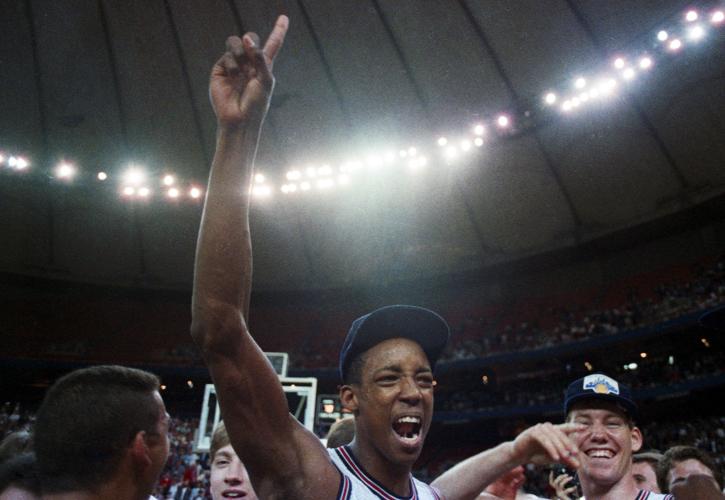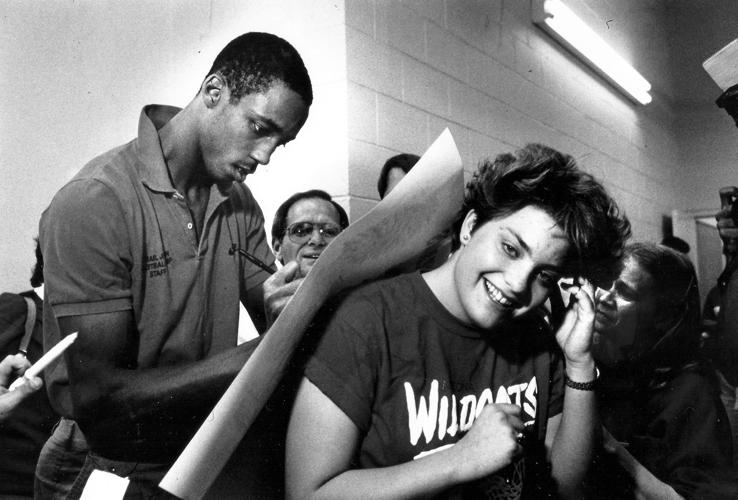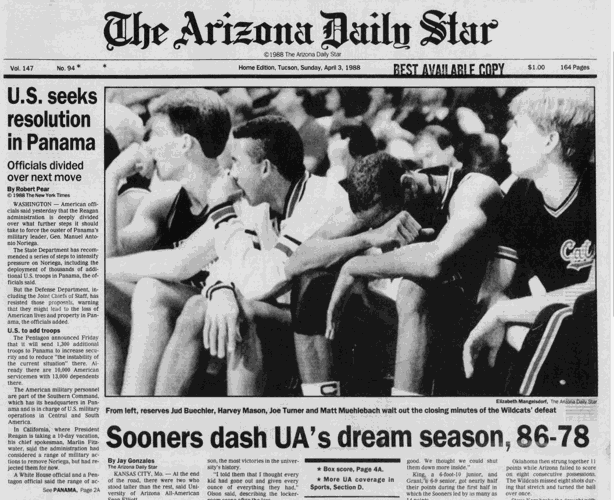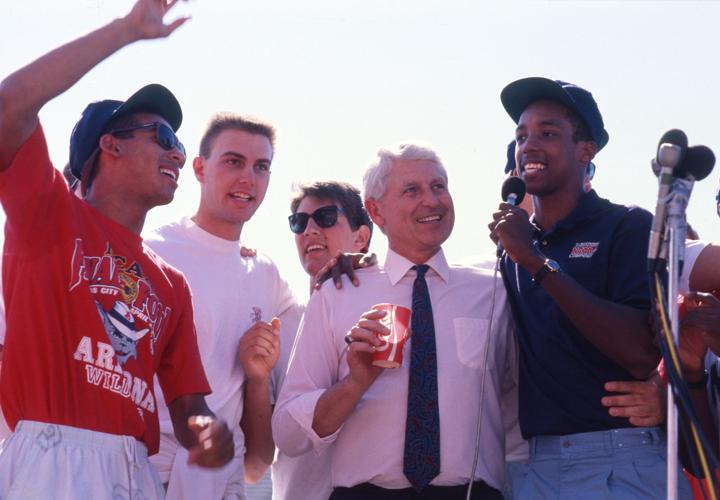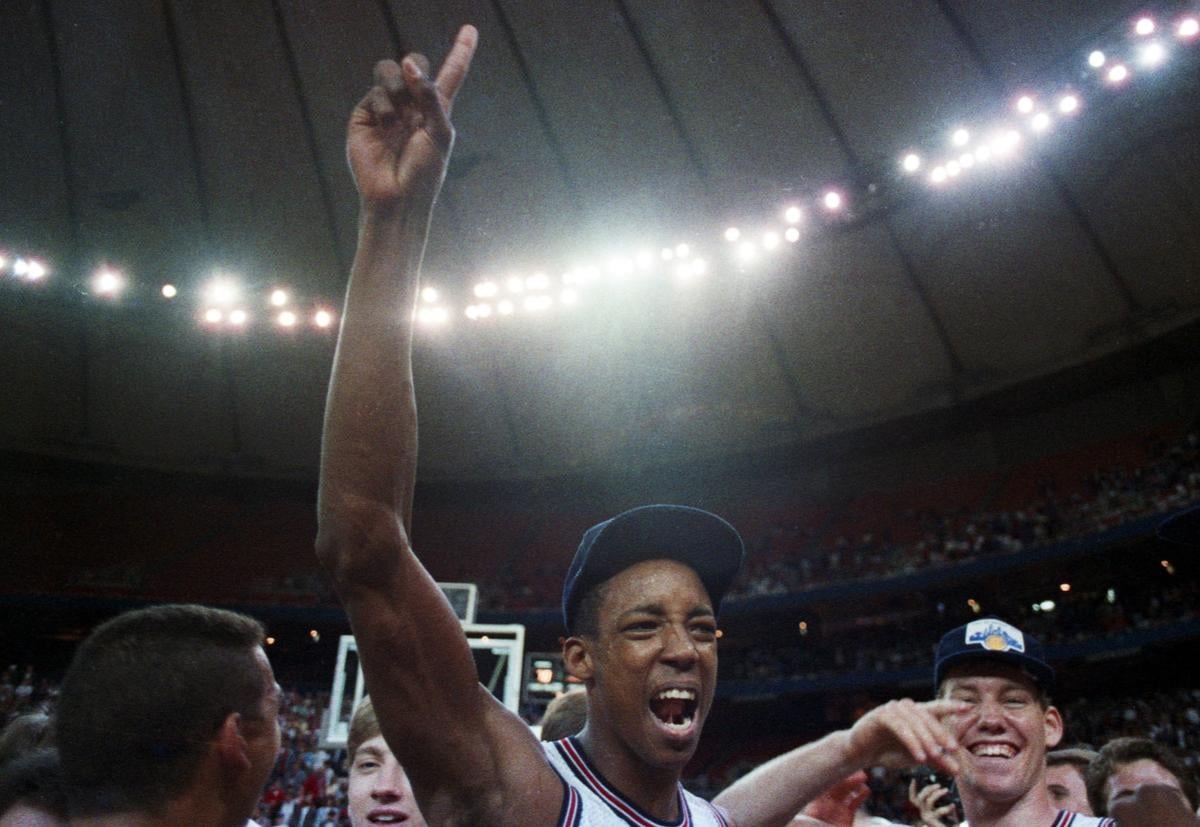Sean Elliott could have been a mercenary, and that would have been just fine.
He could have left Cholla High School all those years ago for, say, Lawrence, Kansas, and he would’ve been celebrated for his accomplishments and welcomed back to Tucson with open arms.
But not with a parade. Not with icon status. Not with the undying love that he receives, now, 30 years later.
It’s one thing to take your talents to find success in someone else’s town.
It something else to lift your own community onto your back and out of obscurity.
When Elliott guided Arizona to its first Final Four 30 years ago this week, he did not just fulfill a basketball goal. He helped turn a town around.

Sean Elliott signs an autograph for a fan. Arizona Daily Star file photo
A 'basketball junkie' stays home
College basketball in Tucson might as well have been a wasteland by the end of January 1983, Elliott’s sophomore year of high school. The Wildcats went 4-24 with former Grand Canyon coach Ben Lindsey in charge. They were somehow worse than that — 1-17 — in Pac-10 play.
Elliott remembers watching Arizona play Oregon in McKale Center, a game the Ducks would win in a thriller, 86-84. Arizona announced a crowd of 6,027, but Elliott hardly anyone went.
“I got seats and I worked myself down to the second row because there was no one at the game,” Elliott said. “It was like an open-gym type of game. There were 1,000 people there, tops. I got almost down to the floor, almost with no problem. At that point, it was like … a community college game. You could hear the guys talking to each other on the court.”
By then, Elliott was just beginning to blossom into a Division I prospect. UTEP showed interest; so did Arizona State.
Arizona wasn’t even on the map.
That all changed when Lute Olson, who had led Iowa to a Final Four, came to town.
“When coach came in, he said 'Get your tickets now; this is going to be a hard ticket to get.' I thought he was talking noise,” Elliott said. “A lot of people thought that. It was really a bold statement. If you’d seen the way it was before….”
One year to the day later, things didn’t appear much better. Those tickets? Still worth about as much as a Sonoran dog. The Wildcats were 3-12 on Jan. 31, 1984.
That night, Olson decided to do some local recruiting. The coach drove to Sunnyside High School in time to watch Elliott — by then a Cholla junior — score 22 points against the Blue Devils.

Sean Elliott (32) of Cholla High School battles the boards against Sunnyside High opponents at Sunnyside on Jan. 31, 1984. Photo by Xavier Gallegos / Tucson Citizen
Olson realized he wanted Elliott, and after the Wildcats finished the season on a 6-2 stretch – with wins over No. 20 Oregon State, USC and, yes, Oregon. Elliott realized Arizona had everything he wanted, too: A chance to win, a chance to star and a chance to do it in his own backyard.
“Being a basketball junkie, I’d never miss college games on Saturday or pro games on Sunday,” Elliott said. “I’d watch the two games on Saturday then go to the YMCA and shoot, and all that was on was the ACC and UCLA. If it wasn’t North Carolina State, it would be Virginia. If it wasn’t Virginia, it’d be Maryland. I thought I’d go to an ACC school. I had dreams to go somewhere else.
“But Lute came in my sophomore year, and my junior year I went and I saw some enthusiasm, and by the end of the year, you couldn’t get a seat. The whole place had changed.”
Elliott stuck with his commitment following a stellar senior season, one in which he averaged 31.3 points for a Cholla team that advanced to the Class 5A state semifinals.
“Sean thought, 'Why do I need to go anywhere else? I have a chance to win, and a chance to win big,'" said Tom Tolbert, Elliott's college teammate. "That was a huge factor. He took a lot of pride. He took a lot of pride in being from there.”
Tucson had Elliott. And soon, Elliott would have Tucson.

Sean Elliott led the UA as the Pac-10's all-time leading scorer.
'We were the big men on campus'
If Arizona started to get its facelift under Olson that first year, it got the whole body package four years later.
The 1987-88 season began with high expectations. The Wildcats were ranked 17th in the preseason, coming off their third straight NCAA Tournament appearance.
Olson had built an arsenal around Elliott. There was Steve Kerr, back in the fold after missing what would have been his senior season in 1986-87 with a knee injury. Craig McMillan, Olson’s first primetime prospect, was a steady veteran presence. Tolbert, a junior college transfer, and Anthony Cook — who’d go on to average 12 points per game in his Arizona career — gave the Wildcats some bulk in the paint. Backup guard Kenny Lofton would go onto become a Major League Baseball star, Jud Buechler would win three NBA titles with the Bulls, and Harvey Mason would win Grammys for his music producing.
The team was as eclectic a mix as Arizona had ever seen, and as talented as they were, their bond was even stronger.
By the end of their first weekend, a three-game thrashing through the Great Alaskan Shootout, the Wildcats were an absolute force. They’d beaten No. 9 Michigan and No. 1 Syracuse up in the Yukon, and when they returned home for their first game at McKale Center on Dec. 4 against Long Beach State, the place was deafening.
“It was a great time. It really was. It was magical — and it all started with Lute coming to Tucson," Elliott said. "He came in and changed the entire thought process. People started to believe we could really do something. That '88 team, we really kicked the door in.”
By the middle of the season, they’d set the whole house on fire. Arizona took over the No. 1 ranking on Dec. 22, 1987, and Tucson was the toast of college hoops. “Billy Packer said we had the best November and December in the history of college hoops,” Elliott recalled.
Playing in front of his hometown crowd, his mother Odiemae and brothers Bobby and Noel, Sean Elliott became a Tucson icon.
“We were the big men on campus,” Elliott said with a laugh. “People would clap when we walked into classrooms. It was pretty insane. They’d all stand up and clap. They were more excited than we were, probably. Everybody was buzzing. The city was on fire. When people would see you and go absolutely crazy, it’s because … it’s almost like we went through this whole process together. The players, the city, the community. We were adored, but I don’t think people looked at us like we were superstars. We were them.”
Then the Wildcats, somehow, got even better. The team lost just one Pac-10 game, at Stanford, and won the Pac-10 Tournament at McKale Center. Arizona earned a No. 1 seed in the NCAA Tournament, then breezed to 40- and 29-point wins in the first weekend over Cornell and Seton Hall. The Wildcats routed Iowa by 20 points in the Sweet 16, and bounced North Carolina by 18 in the Elite Eight.
The Wildcats practically floated to Kansas City, Missouri, where they'd play in the program's first-ever Final Four.

Coach Lute Olson is beaming while listening to star player Sean Elliott at a rally and parade at for the men's basketball team at University of Arizona stadium in Tucson after the 1988 NCAA Final Four.
'We enjoyed the moment'
Saturday, April 2, 1988.
The Wildcats had all the momentum in the world, and they were ready to pounce on Oklahoma in the national semifinal.
Only…
The Sooners scared the socks off of Kerr, who shot 2 for 13 from the field — and 2 of 12 from 3-point range — in a game he'd go on to call the biggest regret of his career. The Wildcats finished just 6 of 23 from long range. They turned the ball over 15 times, and had just two steals.
Elliott finished 31 points on 13 of 23 shooting while grabbing 11 rebounds. He also had six turnovers and four fouls against Oklahoma's two best big men, future NBAers Harvey Grant and Stacey King. The Sooners duo combined to score 42 points.

The Final Four loss was an abrupt end to what had been the ride of Elliott’s life.
He would go on to become the Pac-10’s all-time leading scorer, breaking Lew Alcindor’s record, and then play 12 years in the NBA. Elliott would win an NBA championship with the San Antonio Spurs in 1999, make two All-Star appearances and return from a kidney transplant to make medical (and basketball) history.
Still…
“The '88 run was one of the most important moments of my career,” Elliott said. “That and the (NBA) championship. I just gave a talk on that in San Antonio. There’s a magical feeling about doing something as a team. There’s a really magical feeling to that. I’ve never seen a guy at an MVP press conference shower himself with champagne. When guys win a championship together, it’s pandemonium. When you talk about the romanticism of college ball, it’s about program-building, bringing in good guys, and there was something special about that team.
“A lot of it was because we enjoyed the moment."
No moment topped the Wildcats' ride home from the airport following the Final Four loss. The team rode in convertibles from the airport to campus, where they would be greeted by a raucous crowd at Arizona Stadium.
"It was lined with people the whole way,” Elliott said, the smile evident in his voice. “We got to the stadium, and there were 20,000 people there. It was astounding.”


